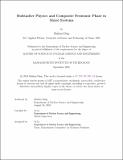Hofstadter Physics and Composite Fermionic Phase in Moiré Systems
Author(s)
Ding, Shuhan
DownloadThesis PDF (8.646Mb)
Advisor
Li, Ju
Terms of use
Metadata
Show full item recordAbstract
This thesis explores the intricate electronic phenomena in Moiré systems, particularly focusing on twisted bilayer transition metal dichalcogenides (TMD). These systems, with their unique superlattice structures and strong electron correlations, provide fertile ground for investigating novel quantum states. A key focus is on understanding Hofstadter physics and the emergence of composite fermion phases in these materials. In this work, we first develop a continuum model to describe the low-energy electronic structure of twisted TMD bilayers, emphasizing the role of the Moiré superlattice in modifying the band structure and introducing non-trivial topological properties. We analyze the resulting Hofstadter spectrum under an external magnetic field, revealing the rich fractal pattern and the impact of valley polarization induced by the magnetic field. Building on this framework, we delve into the concept of composite fermions, particularly in the context of the fractional quantum Hall effect (FQHE). We extend Jain’s composite fermion theory and the Chern-Simons field theory to Moiré TMD systems, proposing the existence of an anomalous composite fermion liquid state at half-filling. Through a detailed mean-field analysis, we demonstrate that this state, characterized by a strong valley polarization and an effective magnetic field arising from Berry curvature, could be energetically favored under certain conditions. Our findings suggest that Moiré TMDs are promising candidates for realizing fractional Chern insulators and other exotic quantum phases, opening up new avenues for experimental exploration and potential applications in quantum technology.
Date issued
2024-09Department
Massachusetts Institute of Technology. Department of Nuclear Science and EngineeringPublisher
Massachusetts Institute of Technology